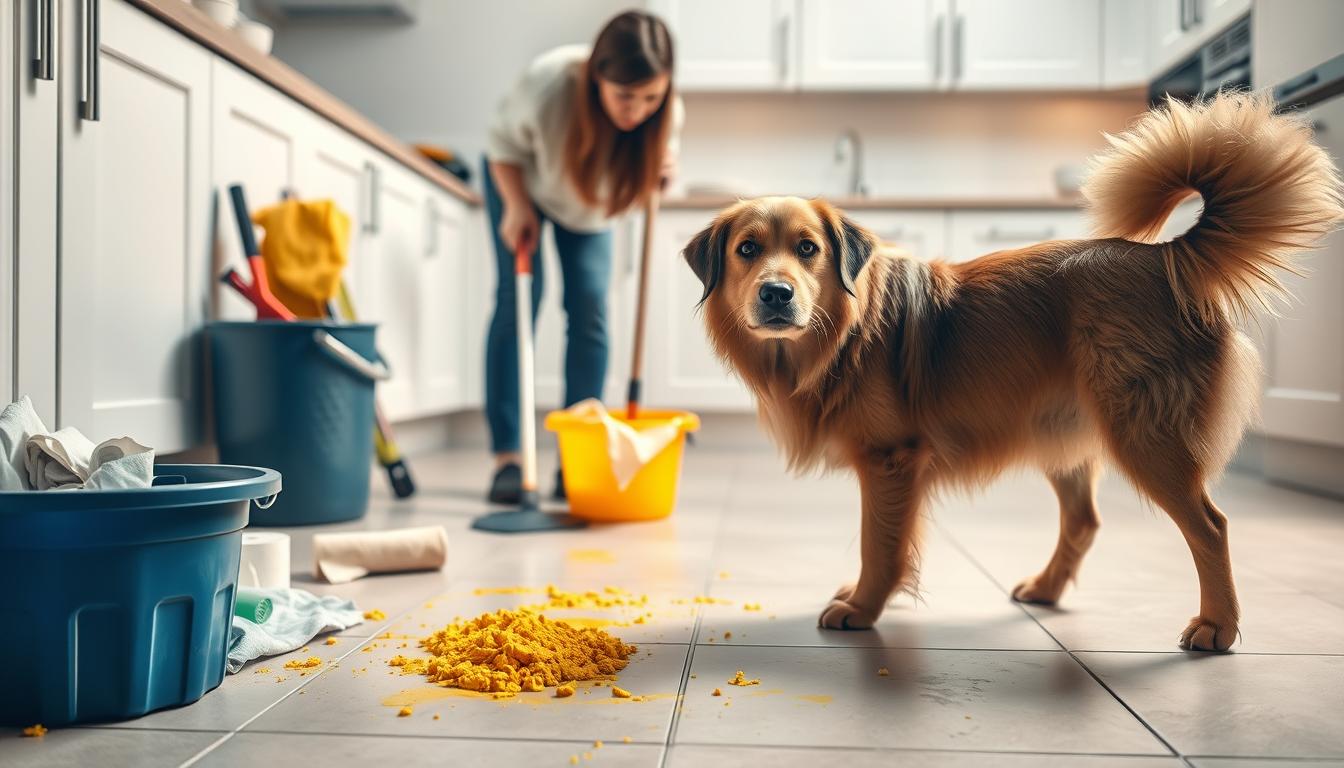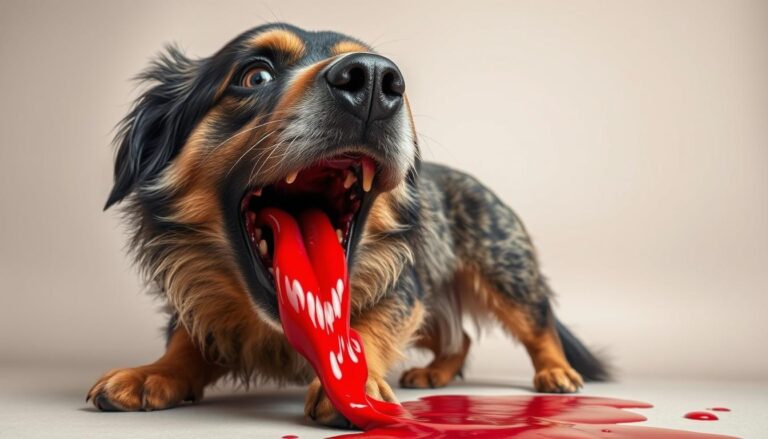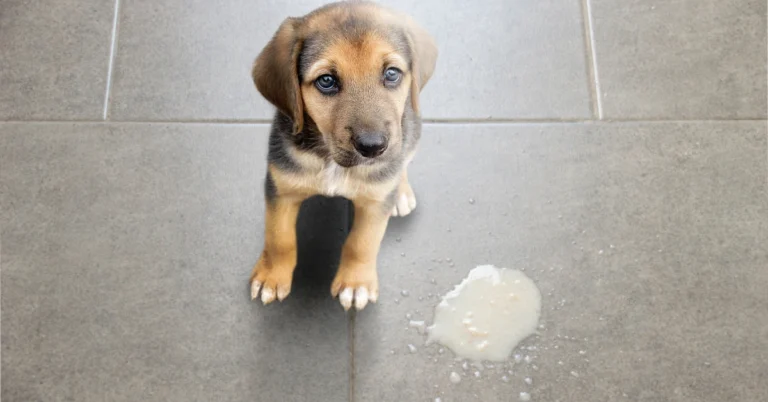Dealing with Yellow Dog Vomit: Tips and Remedies
Ever found yellow foam on the floor and wondered why your dog keeps vomiting it? Yellow dog vomit is common, but knowing why and how to stop it is crucial for your dog’s health. This guide explains the science, practical steps, and prevention tips.
Yellow vomit in dogs usually means they have digestive issues like bile buildup or stomach acid. While sometimes it’s not a big deal, if it keeps happening, it might mean there’s something serious going on. This article will help you spot warning signs, use home remedies, and know when to see a vet. All these are important for keeping your pet healthy.
Table of Contents
Understanding Why Your Dog is Vomiting Yellow
Yellow vomit in dogs often starts with bile, a fluid made by your dog’s liver. When your dog’s stomach stays empty too long, bile can irritate the stomach lining and cause vomiting. Here’s what you need to know:
The Science Behind Yellow Dog Vomit
Bile helps digest fats but turns yellow when mixed with stomach acid. If your dog hasn’t eaten recently, bile buildup might trigger yellow vomit in dogs. This is common in dogs with irregular feeding schedules or those prone to an empty stomach.
Common Causes of Yellow Bile in Dogs
Several factors can lead to canine vomiting:
- Empty stomach: Bilious vomiting syndrome from fasting too long
- Poor diet: Spoiled food or sudden diet changes
- Ingested toxins: Foreign objects or plants
- Medical issues: Allergies or pancreatitis
Differences Between Vomit and Regurgitation
Knowing the difference guides treatment:
| Feature | Vomit | Regurgitation |
|---|---|---|
| Process | Forceful expulsion from stomach | Passive expulsion from esophagus |
| Content | Bile, digested food | Undigested food, mucus |
| Timing | Often after lying down | Soon after eating |
If your dog shows repeated why is my dog vomiting yellow, consult a vet to rule out serious conditions. Quick action helps prevent dehydration or nutrient loss.
Immediate Steps to Take When Your Dog Throws Up Yellow
If your dog is dog throwing up yellow, act quickly but calmly. Remove all food and water for 4-6 hours to let their stomach settle. Watch their behavior closely during this time.
- Check for additional symptoms like lethargy, diarrhea, or abdominal swelling. Note how often vomiting occurs.
- After fasting, offer small sips of water every 20 minutes to prevent dehydration without overwhelming their system.
- Once 6 hours pass without vomiting, reintroduce bland meals slowly. Mix boiled chicken (no seasoning) with plain rice in small portions.
Monitor their response over 24 hours. Avoid common triggers like table scraps or sudden diet changes during recovery. Keep a symptom log noting frequency, color, and consistency of vomit.
| Sign to Watch For | Action to Take |
|---|---|
| Single episode with no other symptoms | Follow home care steps above |
| Repeated vomiting or blood in vomit | Seek dog vomiting treatment from a vet immediately |
| Loss of appetite for over 24 hours | Contact a veterinarian |
Incorporate these dog care practices into your routine to reduce recurrence. Always prioritize safety by assessing severity before proceeding with home remedies.
Home Remedies for Yellow Dog Vomit
If your dog is vomiting yellow foam, making a few changes can help. Start with gentle food changes and make sure they drink enough water. Always talk to a vet before trying new remedies.
Dietary Adjustments That Help
Feed your dog small meals often to avoid upsetting their stomach. Choose foods like boiled chicken and white rice. Adding probiotics, like Purina FortiFlora, can also help. For 24–48 hours, avoid giving them fatty or rich foods.
Hydration Techniques
Help your dog drink more by offering ice cubes or Pedialyte (mixed 50/50 with water). Wet food can also help them stay hydrated. Keep an eye on how much water they drink to prevent dehydration.
Over-the-Counter Options
Some OTC products can be safe with a vet’s okay. Here are some options:
| Product Type | Example | Usage Note |
|---|---|---|
| Antacid | Pepcid AC (famotidine) | 0.5–1 mg/lb of body weight, with vet approval |
| Probiotic | Nutramax Digestive Support | Follow label instructions for dosage |
| Digestive Enzymes | Novus Prozyme | Added to meals to aid nutrient absorption |
Never give your dog medicine without a vet’s say-so. If their symptoms are severe, they need to see a vet.
When to Seek Veterinary Care for Dog Vomiting Yellow Foam
If your dog is vomiting yellow foam and shows other signs, get veterinary advice fast. Early help is key to keeping your dog healthy.

- Recurring episodes: Vomiting more than 3 times in 24 hours.
- Blood in vomit: Bright red or coffee-ground-like material signals internal issues.
- Dehydration: Sunken eyes, dry gums, or skin that doesn’t spring back when pinched.
- Additional symptoms: Diarrhea, fever, weakness, or whining when touched.
- Foreign object ingestion: Suspected swallowed items like toys or bones.
| Symptom | Action Required |
|---|---|
| Vomiting + diarrhea | Visit vet within 2 hours |
| Blood in vomit | Emergency care immediately |
| Lethargy lasting >24 hours | Call vet office now |
| Severe abdominal pain (whining, panting) | Go to nearest emergency clinic |
Puppies, senior dogs, or pets with diabetes, kidney disease, or past digestive problems need quick care. Don’t wait if your dog shows many warning signs. Fast veterinary advice can help your dog recover better.
Preventing Future Episodes of Yellow Dog Vomit
Keeping your dog healthy starts with small changes. Adjusting their diet and environment can help. This can lower the chance of yellow dog vomit and keep their digestive system healthy.
Feeding Schedule Adjustments
Keep a regular feeding schedule to prevent an empty stomach. Give your dog smaller meals every 4–6 hours. Never skip breakfast, as it can cause bile buildup.
Use slow-feed bowls or puzzle toys to slow down eating. This can help prevent stress-induced vomiting.
Dietary Considerations
Choose dog food with real protein like chicken or fish. Avoid giving your dog human foods, grapes, or chocolate. Introduce new foods slowly over 7 days to watch for any bad reactions.
Limit table scraps and give fiber-rich foods like pumpkin. They help with digestion.
Lifestyle Changes to Reduce Stress
Stress can harm your dog’s digestion. Create calm routines like morning walks and playtime. Make sure they have a quiet place during storms.
Use pheromone diffusers or calming wraps for anxious dogs. Regular exercise, like daily walks, helps keep their gut healthy. Try to avoid sudden changes in their environment or routine.
Cleaning Up After Your Dog’s Yellow Vomit
Accidents happen, and cleaning up yellow dog vomit is crucial. It keeps your home safe and your pet healthy. First, remove solid parts with paper towels. Then, tackle stains and smells to avoid future messes. Here’s how to clean different surfaces well:

- Wear disposable gloves and gather supplies like enzyme-based cleaners or baking soda.
- Blot stains gently—rubbing can set in stains. Rinse with water after treatment.
| Surface | Cleaning Method | Recommended Product |
|---|---|---|
| Hardwood | Spot clean with vinegar-water mix or commercial pet-safe cleaner | Simple Solution Stain & Odor Remover |
| Carpets | Apply baking soda, let sit, then vacuum | Nature’s Miracle Stain Remover |
| Upholstery | Test fabric-safe cleaner on a small area first | ST草天然宠物清洁剂 |
For smells that linger, mix equal parts water and white vinegar in a spray bottle. Stay away from ammonia-based products, as they can draw pets. Always wash your hands well after cleaning to keep up with dog care standards. Dispose of materials properly to avoid spreading germs. Keeping your pet’s health in mind means cleaning thoroughly but safely—never use harsh chemicals near your dog. Regular deep cleaning of high-risk areas helps reduce stress and messes.
Other Health Concerns Related to Dog Vomiting Mucus
Yellow vomit isn’t the only worry when your dog is sick. Canine vomiting can show different health problems. Let’s look at what colors mean and when to seek help.
Yellow Vomit vs. Other Colored Vomit
| Color | Description | Possible Causes |
|---|---|---|
| Yellow | Bile-stained fluid | Empty stomach or bile reflux |
| White | Mucus-rich discharge | Stomach irritation or ulcers |
| Green | Bile mixed with partially digested food | Intestinal blockage or pancreatitis |
| Brown | Old blood or digested material | Internal bleeding or foreign objects |
| Red | Fresh blood | Ulcers, tumors, or trauma |
Accompanying Symptoms to Watch For
- Lethargy: Could signal systemic illness like parvo or kidney failure.
- Diarrhea: Combined with vomiting may indicate food poisoning or parasites.
- Abdominal swelling: Urgently seek help if paired with green or brown vomit—this could be bloat.
Breed-Specific Considerations
Brachycephalic breeds like Bulldogs and Pugs> often regurgitate undigested food. Deep-chested breeds such as Great Danes face higher bloat risk. German Shepherds may suffer from chronic stomach sensitivities. Monitor your dog’s habits closely based on their breed traits.
Being aware of these details helps you react fast in dog health emergencies. Always consult a vet when symptoms persist or worsen.
Conclusion: Maintaining Your Dog’s Digestive Health
Keeping your dog’s digestive system healthy starts with spotting early signs like yellow vomit. If your dog shows symptoms, quick action is key. This can include changing their diet and making sure they drink enough water. Remember, dog vomiting treatment often focuses on finding and fixing the main problem.
Regular vet visits are crucial for your pet’s health. Stick to a feeding schedule to avoid stomach upset. Choose foods high in fiber and easy to digest. Also, make sure your dog always has clean water to drink. These steps are important for your dog’s long-term health.
Stress and the environment can also affect your dog’s digestion. Keeping your dog calm and in a stress-free place helps. If your dog’s symptoms don’t go away, get professional help right away. Working with your vet helps you handle both immediate problems and long-term care.
Yellow vomit doesn’t always mean a big problem, but you should always be careful. Focus on good nutrition, enough water, and regular vet visits. By being proactive and knowing the signs of trouble, you can help your dog stay healthy.
FAQ
Why is my dog vomiting yellow foam?
Yellow foam in dog vomit often means there’s bile. This can happen when a dog’s stomach is empty. It might be due to bilious vomiting syndrome, irritants, or changes in their diet.
What can cause my dog to vomit yellow mucus?
Vomiting yellow mucus can mean irritation or inflammation in your dog’s digestive tract. It could be from eating things they shouldn’t, stress, or health issues. Keep a close eye on it.
How should I respond if my dog throws up yellow bile?
If your dog vomits yellow bile, watch for other signs like tiredness or not wanting to eat. Don’t feed them for a bit but make sure they have water. Once they stop vomiting, start with bland food again.
When should I be concerned about my dog’s yellow vomit?
See a vet if your dog vomits a lot (more than 2-3 times in 24 hours), seems in pain, has blood in their vomit, or looks dehydrated. These signs could mean serious health problems.
Are there home remedies for a dog vomiting yellow?
Yes, you can try feeding your dog smaller meals more often with easy-to-digest foods and make sure they drink enough water. You can also use probiotics and antacids, but talk to your vet first.
Are some dog breeds more prone to vomiting yellow bile?
Yes, some breeds like Bulldogs and German Shepherds with sensitive stomachs might vomit yellow more often. Watching their diet and stress can help prevent it.



